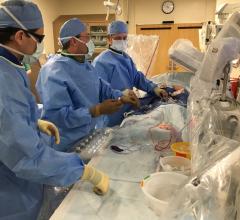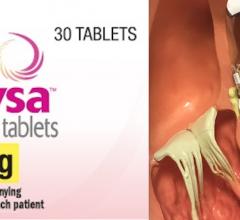
September 30, 2019 – The first randomized trial to compare a durable polymer drug-eluting stent to a polymer-free drug-coated stent in patients at high risk of bleeding and treated with one-month dual antiplatelet therapy (DAPT) found that both are clinically safe and effective.
Findings from the Onyx ONE trial were reported at the 31st annual Transcatheter Cardiovascular Therapeutics (TCT) scientific symposium, Sept. 25-29 in San Francisco, sponsored by the Cardiovascular Research Foundation (CRF).
Up to 40 percent of patients undergoing percutaneous coronary intervention (PCI) have high bleeding risk (HBR) characteristics, and current guidelines recommend three to six months of DAPT for HBR patients undergoing PCI, with consideration for DAPT duration as short as one month in selected patients. However, there are scant randomized data with shorter durations of DAPT, especially for current-generation polymer-based DES. The Onyx ONE trial compared a polymer-based DES compared to polymer-free drug-coated stents (DCS) in HBR patients treated with one-month DAPT (aspirin and an oral P2Y12 inhibitor).
The prospective, multicenter, single-blind randomized trial enrolled 2,000 HBR patients who were randomized 1:1 at 84 global sites. The primary safety endpoint was cardiac death, myocardial infarction (MI) or definite/probable stent thrombosis at one year. The powered secondary endpoint was target lesion failure, a composite of cardiac death, target vessel myocardial infarction or clinically driven target lesion revascularization. Other secondary endpoints included device and procedure success rates, Bleeding Academic Research Consortium (BARC) bleeding, and the individual components of the primary endpoints.
Of the 1,996 patients randomized, one-year follow-up was available in 98.5 percent (n=988) of the ZES arm and 97.6 percent (n=969) of the DCS arm. Baseline and lesion characteristics were similar among both groups. Crossover to an alternative stent occurred more frequently in the DCS arm (40 vs. 2, p<0.001), and ZES showed improved angiographic outcomes resulting in greater device success post-PCI (92.8 percent for ZES and 89.7 percent for DCS, p=0.007). At two months after PCI, 92 percent of patients were on single antiplatelet therapy and 88 percent were at one year. The primary safety endpoint of cardiac death, MI or definite/probable stent thrombosis at one year was 17.1 percent for ZES and 16.9 percent for DCS (Pnon-inferiority = 0.011). In addition, the powered secondary effectiveness endpoint of TLF at one year was 18 percent for ZES and 17.9 percent for DCS (HR 1.02, 95 percent CI [0.83, 1.26], p=0.84). Bleeding rates were also similar among both treatment groups.
“The Onyx ONE global randomized trial is the first study to evaluate outcomes between a polymer-based DES and a polymer-free DCS with one-month DAPT after PCI in a complex patient population,” said Stephan Windecker, M.D., director and chief physician, Department of Cardiology at the Swiss Cardiovascular Center in Bern, Switzerland. “The data shows that the polymer-based zotarolimus-eluting stent is as safe and effective as the polymer-free drug-coated stent in HBR patients treated with one- month DAPT and provides important evidence to inform clinical decision-making for high bleeding risk patients.”
The Onyx ONE study was funded by Medtronic. Windecker disclosed research grants to the institution from Abbott, Amgen, Bayer, Bristol Myers-Squibb, Boston Scientific, Biotronik, CLS Behring, Edwards Lifesciences, Medtronic, Polares and Sinomed.
More late-breaking coverage of TCT 2019
For more information: www.crf.org/tct


 August 28, 2023
August 28, 2023 









